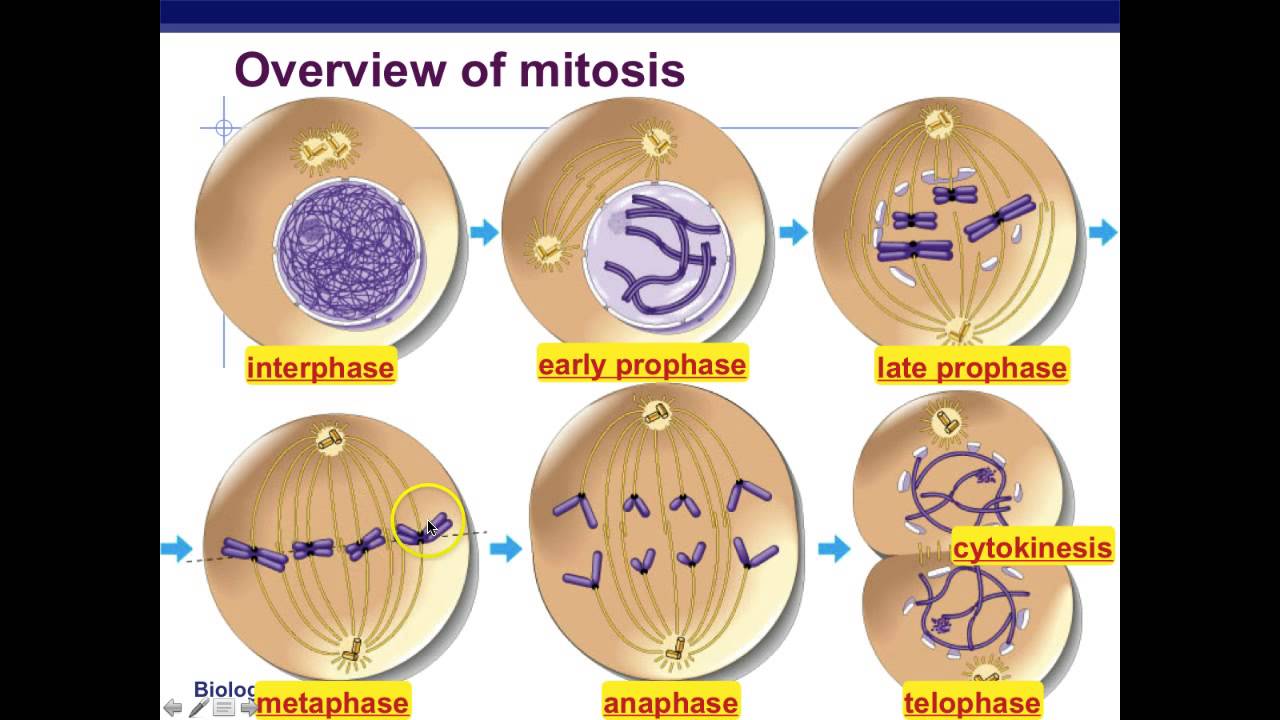Mitosis: mitotic cell division, stages and significance
- Mitosis is a type of cell division in which single haploid cell (n) or diploid cell (2n) divides into two haploid or diploid daughter cells that are same as parent.
- Mitosis occurs in somatic cells of plants and animals. In this cell division, the two daughter cells have same number of chromosomes as that in the parent cells.
The process of mitosis consists of the following stages or phases:
- Interphase or Interkinesis
- Karyokinesis
- Cytokinesis

1. Interphase or interkinesis
- Interphase is the phase between two successive cell division (end of one cell division to the beginning of next cell division).
- It is the longest phase in the cell cycle.
- Interphase looks dormant but it is metabolically active stage.
It is divided into 3 sub-stages viz. G1-phase, S-phase and G2-phase.
i. G1-Phase or Gap-1 phase
- The cell grows in size due to active biosynthesis.
- Formation of structural and functional proteins.
- Synthesis of mRNA, tRNA and rRNA takes place.
ii. S-Phase or Synthetic phase
- Replication of DNA takes place.
- Synthesis of histone proteins takes place which covers DNA.
iii. G2-Phase or Gap-two phase or Second growth phase
- RNA and protein is synthesize.
- Centrioles get replicate (in case of animal cell)
- Synthesis of spindle proteins takes place.
2. Karyokinesis
- Karyokinesis is the division of the nucleus.
- It consists of the following four phases.
i. Prophase
- It is the first visible stage in karyokinesis.
- The chromosomes appear as long coiled threads called chromatids.
- The chromatin becomes shorter, thicker and visible due to the condensation of DNA.
- The chromatins are now called chromosomes.
- Stainability of nucleus increase.
- Each chromosome starts to splits longitudinally into two sister chromatids. These sister chromatids are attached with each other at centromere.
- The nuclear membrane and nucleolus starts to disappear and by the end it will completely disappeared.
ii. Metaphase
- Nuclear membrane and nucleolus completely disappears and simultaneously appearance of spindle fibres
- Spindle fibres attached to the centromere of chromosome.
- The chromosomes are arranged on the equatorial plane.
- The process of gathering of chromosomes in equator is called congression and plate formed is called metaphasic plate.
iii. Anaphase
- The centromere of each chromosome splits into two sister chromatids and forms two daughter chromosomes.
- The daughter chromosomes are pulled towards the poles due to the contraction of spindle fibres and stretching of inter zonal fibres.
- During polar movement, the chromosomes shows different shapes i.e. J,U,V,L or I shaped in appearance.
- At the end of anaphase, each pole will get one set of daughter chromosomes.
- It is shortest phase and is also known as migratory phase.
iv. Telophase
- The daughter chromosomes reach respective poles and uncoil and become thin, long and visible.
- The spindle fibres start disappearing and finally disappear.
- The nuclear membrane and the nucleolus reappear.
- Two nuclei are formed at the end of telophase. Both the nuclei have the same number of chromosome as parent cell.
- It is the last visible stage of karyokinesis and is also known as reorganization phase.
3. Cytokinesis
- Cytokinesis is the division of the cytoplasm.
- In plant cells, cytokinesis occurs by cell plate formation.
- During cytokinesis, many granular matrix formed by the golgibody and endoplasmic reticulum accumulates in the equatorial region. These granular matrix form cell plate. This plate divides the cell and by the end of telophase, cytokinesis is completed.
- In animal cells, cytokinesis occurs by cleavage or furrow formation.
SIGNIFICANCE OF MITOSIS:
- Mitosis produces 2 genetically identical cells, so mitosis maintains the genetic stability of organisms.
- DNA remains constant, so mitosis keeps the chromosomes number constant in a species.
- Mitosis helps in the development of multicellular organism.
- Mitosis helps to replacement of old, dead or damaged cells by new one.
- It helps in the recovery of wounds and injury of the body by formation of new cells.
- In unicellular organisms like Yeast, Paramecium , mitosis is a means of asexual reproduction.
- Mitosis causes maturation and multiplication of germ cells and makes them ready for meiosis.
